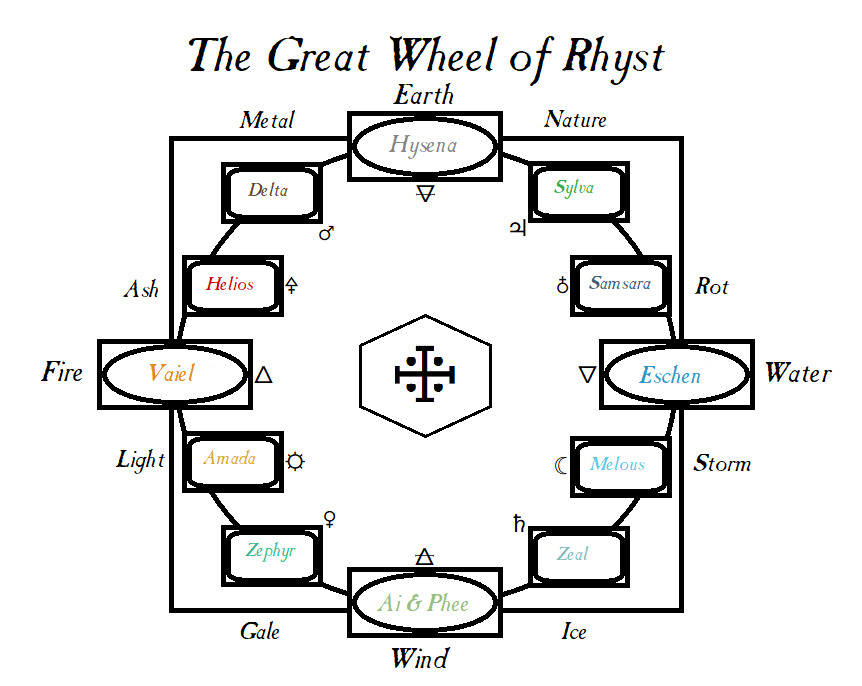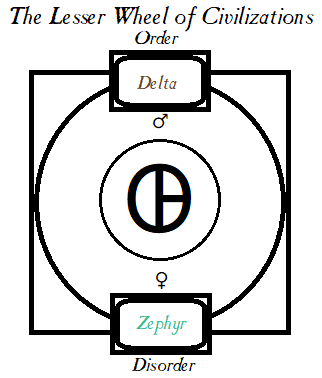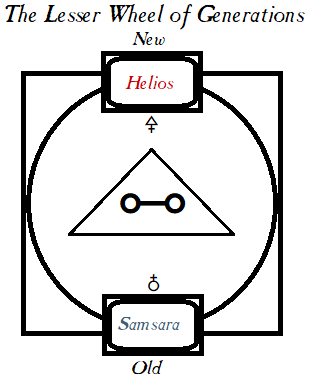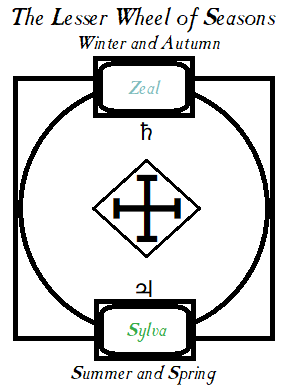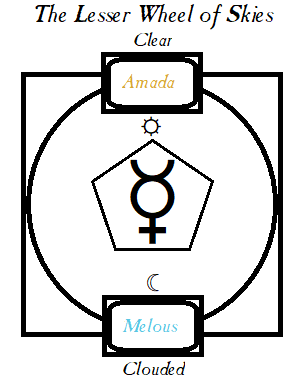Cosmology of Spiritualism
An Introduction into Spiritual Cosmology[edit]
Throughout the vast history of Rhyst, many civilizations have risen and many have fallen. Yet throughout it all, the Spirits- and the worship of them- has persisted for nearly as long as humanity has. Due to this, a great value has historically been placed upon them and the symbols constructed through their worship. The greatest of these symbols are the conception of wheels and of cycles due to our plane's great focus upon 'balance.' Fire is kept in check by water, and earth is kept in check by air. There is neither an excess of mana, nor a dearth of it.
It is largely due to this overwhelming focus and idolization of the concept of cosmic balance that has lead to some of the quirks of the various Spirit cults throughout Rhyst. One amongst them being the creation of assorted star charts, compasses, and maps intended to represent the greatest Spirits; and another being esoteric methods of keeping time. Perhaps the greatest of these, however, are the so-called Five Wheels of Rhyst.
The Five Wheels of Rhyst are five cosmological concepts that became popularized throughout the Spirit cults of Rhyst, and have become a popular symbol of Spiritualism as a whole. They are thought to be derived from both the focus on balance, as well as from old maps depicting the mythical Valley of Elae- and assign the elements and spirits to different directions.
The Great Wheel of Rhyst[edit]
The Great Wheel of Rhyst is the first of the Five, and is an esoteric cosmological diagram that the other Four are largely based around it. It is used to determine the direction of temples or shrines within settlements, and the location of altars within larger temples. It originates from maps of the Valley of Elae, and is based on the direction of the settlements of the Hysen, Eschen, Aiphe, and Vaien.
Accordingly, the wheel acts as a sort of compass: the Element of Earth lies to the North, Wind to the South, Fire to the West, and Water to the East. This is in accordance of the rough placement of the settlements of the four progenitor species of humanity, and provides the basis for the placement of Spirits within the Wheel.
Directly to the North is Hysena, with Delta placed slightly to the Northwest and Sylva slightly to the Northeast.
Directly to the South is Ai and Phee, with Zephyr placed slightly to the Southwest and Zeal slightly to the Southeast.
Directly to the West is Vaiel, with Helios placed slightly to the Northwest and Amada slightly to the Southwest.
Directly to the East is Eschen, with Samsara placed slightly to the Northeast and Melous slightly to the Southeast.
The placement of each Spirit and Element puts them on opposite sides of the ones that would traditionally oppose it. As an example, Vaiel and Eschen- Spirits of Fire and Water respectively- are placed on opposite sides from one another. Those with more vague domains are placed between two elements.
Helios, as an example, is a Spirit of Fire with a focus upon ash: produced through the burning of Earth. As such, he is placed between Fire and Earth to represent this relationship. Likewise, Delta is a Spirit of Earth with a focus upon metal: forged through the usage of Fire. This is true for all of the Spirits upon the Great Wheel.
These placements play an additional part in the Four Lesser Wheels of Rhyst, which are constructs of philosophy concerning the associations of different Spirits and the beliefs followers have traditionally associated with them. They are the Lesser Wheels of Civilizations, of Generations, of Seasons, and of Skies. The Former of the two have more to with humanity, whereas the latter two are more focused upon the natural world. For the placement of Spirits upon these Lesser Wheels, it compares the perceived opposites of those that don't hold a cardinal direction. Spirits of Fire that hold some aspects of Earth and of Air will be placed against Spirits of Water with the same aspect as them, and the same law applies to Spirits of Earth and of Wind.
The Lesser Wheel of Civilizations[edit]
The Lesser Wheel of Civilizations places the Spirits Delta and Zephyr against one another. It deals directly with human civilization, and as such it looks at them in regards as to what they represent and what their specific domains symbolize. It's traditionally used as a scale for civilizations to measure the power of their leadership against the freedoms of their people. An idea typically associated with this Wheel is that an excess of both is largely unhealthy for the civilization measured by the Wheel. An excess of Order leads to tyranny; an excess of Disorder leads to lawlessness. This Wheel is typically invoked during legal disputes.
The Lesser Wheel of Generations[edit]
The Lesser Wheel of Generations places the Spirits Helios and Samsara against one another. It's also commonly known as the Cycle of Life and of Death- or the Cycle, for short- as it presents the two spirits as deities of both life and death. Within it, Helios represents the destruction of the Old and the creation of the New; whereas Samsara represents the decomposition of the New and the preservation of the Old. This Wheel is typically invoked by priests during funerals or during ritual baptisms for young inductees into Spirit cults that do such things.
The Lesser Wheel of Seasons[edit]
The Lesser Wheel of Seasons places the Spirits Zeal and Sylva against one another. It deals specifically with, as its name would imply, the seasons of Rhyst. Following it, Zeal is used to represent the seasons of Winter and Autumn, whereas Sylva represents the seasons of Summer and Spring. It establishes a cycle, in which Zeal will spread cold throughout Rhyst and Sylva will then spread growth. This Wheel is typically invoked to ask for mild winters and cool summers, and is largely one of the more important ones due to its association with the natural changes of the world.
The Lesser Wheel of Skies[edit]
The Lesser Wheel of Skies places the Spirits Amada and Melous against one another. It deals with the weather of Rhyst, and it presents Amada as a deity of Clear skies and fair weather, while Melous is presented as a deity of Clouded skies and storms. Traditionally, this is used to represent the various shifts of weather throughout Rhyst as Amada and Melous working together or working against eachother to achieve a stable system of weather upon Rhyst. This Wheel is typically invoked to ask for rain or fair weather, depending on the circumstances of the environment in question.
Great Rhystian Calandar[edit]
As mentioned before, the Greater Wheel of Rhyst has also been used as a calendar of sorts. Though incredibly antiquated, it still sees some use- mostly for the timing of religious ceremonies or of magical rituals. Whereas our current calendar places more of a focus upon the year, the so-called Elaen calendar places more focus on 'Epochs.' Each Epoch is composed of three years, and represents one of the four Elements- and once all four Epochs have passed, a single 'Cycle' is said to have passed.
Every Cycle begins with the Epoch of Earth, which then moves into the Epoch of Water, then the Epoch of Wind, and ends with the Epoch of Fire; moving clockwise with the Greater Wheel as its reference.
Each specific Spirit is meant to represent a year within their respective Epochs, as well. For example:
The Epoch of Earth contains the Year of Delta, Year of Hysena, and the Year of Sylva.
The Epoch of Water contains the Year of Samsara, Year of Eschen, and the Year of Melous.
The Epoch of Wind contains the Year of Zeal, Year of Ai & Phee, and the Year of Zephyr.
The Epoch of Fire contains the Year of Amada, Year of Vaiel, and the Year of Helios.
Using the date of 800AC as an example, the date in the Elaen Calender would be written as such: The Year of Zephyr in the Epoch of Wind in the 66th Cycle.
In addition, the Greater Wheel of Rhyst has also traditionally been used to assign each hour of a day a Spirit. Hysena would represent 12 o'clock, Eschen would represent 3 o'clock, Ai & Phee would represent 6 o'clock, and Vaiel would represent 9 o'clock. The hours in between would be represented by the other eight, as well.
(As of the date of writing, 1011AC, it would be the Year of Samsara in the Epoch of Water in the 85th Cycle.)
Credit[edit]
Retatouille https://forum.verdict.dev/showthread.php?tid=960
